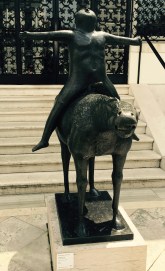Well I’ve reached the half-way mark of my sojourn in Milan. What do I think so far? Its absolutely fabuloso!

Venice Carnivale
While the snow and freezing temperatures took its toll in the first month, the temperatures in Milan have now definitely improved. La primavera is well and truly setting a much warmer scene for the remainder of my stay.
It’s no surprise that I have learned a lot more about Milan since arriving. My Universita Cattolica subject, Reading Milan, is as interesting and revealing as I had hoped it would be. My lecturers have pointed out that reminders of Milan’s Roman and Medieval past are constantly being uncovered. Age-old skeletons have been unearthed as a new underground metro station is being dug alongside the Basilica Sant’Ambrogio to which Universita Cattolica is associated. Even under the Duomo metro station it is possible to see the original base of the Duomo Piazza and realize how much of the existing urban space has been layered and layered upon centuries-old foundations. Even within the Italian Borsa (Stock Exchange building) I was able to see through a glass sub-floor to the remains of Roman foundations during a rare weekend when the building was opened to the public.

Milan’s Duke in the left foreground
I have spent nearly every day since I arrived exploring different parts of the city, using its public transport system, either the metro or trams. Having a bucket-list of reasons to get around the city, such as hanging around Gucci’s compound during Milan Fashion Week show has helped expose me to areas outside the inner-Duomo and tourist precincts.
I was surprised to learn that Milan once resembled Amsterdam with a network of canals to enhance commerce and trade for its merchants until the Fascist government in 1920s decided that the canals were outdated and changed the urban landscape with a road network for modern motor vehicles.
I have been blessed to experience life-long dreams and absorb many beautiful treasures here, such as visiting Venice during Carnivale, attending a performance at Teatro La Scala, observing the goings-on outside 5 fashion houses during Milan Fashion Week, viewing some wonderful art exhibitions of Picasso, Paul Klee and the treasures of the Brera and Gallerie d’Arte Moderna.
I’ve loved seeing the Milanese’s affection for their pets and I have no problem sharing trams, cafes and elevators with dogs of all sizes and breeds, including Great Danes and British Bulldogs!

Dante’s Inferno: Francesca & Paolo
Do I feel like I’m starting to fit in? Well, my local barista now blows me a kiss each morning when he makes me my macchiato, and during a stroll through Sempione Park Marco, an architect from Florence, chatted me up. As it turned out he incorrectly thought the architect of the Galleria Vittorio Emanuele II was also the architect of Arco delle Pace – when in fact one was Guiseppe and the other Luigi!
Just this weekend, I had the sense of taking a magical carpet ride on a visit inside Gucci’s Hub. This is the brand’s marketing complex located in Milan’s outer district in Via Mecenate. In the 1920s the premises were home to the Caproni aeronautical factory. Unfortunately no photos were allowed but the images will remain imprinted on my mind for some time! I will never forget walking into what was obviously an airplane hangar now metamorphosed into a formal banquet space while beyond a lavish and seemingly endless expanse of black draping were a large stage and it is in this compound that all of Gucci’s fashion shows are held. Surrounding a cloistered garden was a modern glass structure that housed showrooms for international buyers and six floors of offices. Again an image imprinted in my mind is walking through huge velvet red doors into a plush red-carpeted showroom complete with mannequins draped with examples from their collection, while handbags of every description were showcased along the walls. Definitely not allowed to touch! Apparently Gucci’s Creative Director, Alessandro Michele selected the vintage and eclectic mix of furniture that grace the buyer spaces and staff lunch area.

Milan’s Navigli canals
So, armed with a new Milano Moda hairdo and having watched Stramilano’s half-marathon from my apartment’s balcony this weekend, I am ready for the next stage of my race around Milano! May it be a saunter rather than a sprint!















